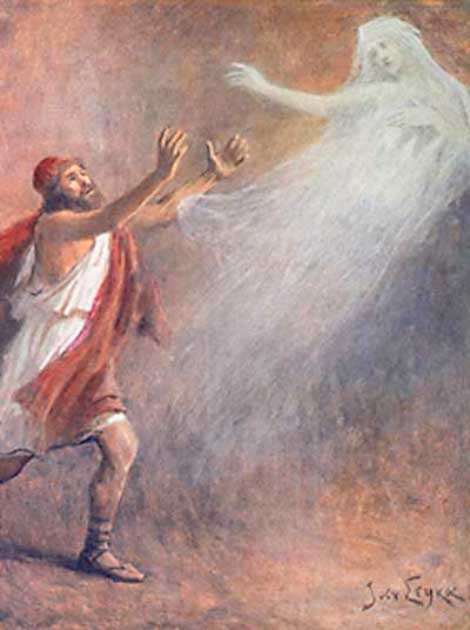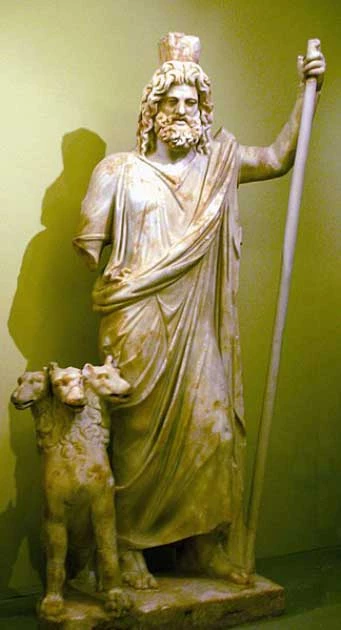Homer’s Odyssey is perhaps the first great travelogue. While it is certainly filled with fantastical creatures, monsters and gods, it is also entirely possible to track the course of Homer’s hero as he spends ten years returning home, traversing much of the ancient Mediterranean as he does so.
Some of the lengthy journey is certainly the fault of Odysseus himself: he probably didn’t need to spend seven years on Calypso’s island, for example. However much of the journey can be parsed as a representation of the dangers, mysteries and hidden secrets of the wine dark sea.
Nowhere is this more apparent than with Odysseus’s interactions with the Oracle of the Dead, unlikely to be Homer’s creation but nevertheless first appearing in this Greek epic. It comes from the island of Circe, among Odysseus’s first encounters but saved as a tale until books nine and ten.
Odysseus tells about how the hero was told by Circe to contact the dead for directions on his future. In the story, Homer sends Odysseus to an entryway of the Underworld to talk to the dead and so understand his future.
On reaching the entryway, the hero is plagued by visions of Hades while talking to the spirit of a dead oracle. But it is the knowledge that he receives which ultimately allows him to free himself from his torments and return to his homeland.
But it is in the representation of the Underworld as something different that we gin an insight into the world of Homer. The Mediterranean is filled with temptations, dangers and fantastic creatures (Circe, for all her powers, is just another of these) and is ruled by a god: your travel around the sea is entirely at the mercy of Poseidon, and much of the Odyssey sees this god punishing the central figure.

Against this, the advice offered by the dead prophet is something never seen elsewhere in the entirely of the poem: a way to overcome Poseidon’s curse. Does the Underworld offer knowledge of how to defeat a god?
A Real Place?
The site where Odysseus tried to talk to the Oracle of the Dead is on top of a hill located at the confluence of three rivers: Acheron, Pyriphlegethon and Cocytus. The site still stands, although in ruins.
The mysterious cave and the ruins which surround it was discovered by Greek archaeologist Sotirios Dakaris in 1958. The ruins have been dated, and their history goes back to the 2nd or 3rd century BC. The ruins are built in the subterranean region with an area of 72 sq ft (6.7 sq m) and walls that are at least 11 feet (3.4 m) thick.
- Lake Avernus Mythology, Oracles, and the Underworld
- Dare You Enter the Ploutonion? Gateway to the Underworld at Hierapolis
The subterranean structure of the cave is proof of the ancient Greek belief that the souls of the dead entered the mortal realm through subterranean fissures that led to the Underworld. In ancient Greece, there were many such structures that let the living talk to the dead, sometimes to allow the dead to visit with the living, and sometimes to reveal their future.
The story of Odysseus is also focused on such an incident where the hero goes to the cave to find the soul of Teiresias, to know more about his future. The hero was instructed in this forbidden rite by Circe, who told him to go to a cave and dig a shallow pit. Once the pit was dug, the hero was instructed to pour libations into the pit to appease the dead.
After he poured the liquids, he prayed to Hades and the dead souls. After praying, Odysseus sacrificed an all-black ram and let the blood pour into the pit for the soul of Tiresias.
Already we see the difficulty of the rite: although he poured the ram’s blood for the soul of Teiresias, there were other souls in the pit that was also thirsty for blood. Different souls drank blood and through this gained the power of speech and recognition.
Before Teiresias spoke to Odysseus, the spirit of Elpenor was first to the trough and spoke to Odysseus. The spirit of Elpenor was a comrade of Odysseus and told him to secure a burial for his dead body.
Did all this, or something like this, happen at the ruins discovered by Dakaris?
Other Accounts
The first mention of the Oracle of the Dead happens in the Odyssey, but its mention in literature and in the later works of Herodotus shows that oracles and Oracles of the Dead were very popular in ancient Greece. These later accounts establish that the dead must be bargained with.
Even in Herodotus, when a husband goes to speak to the spirit of his dead wife to know about the location of a treasure, she refuses to tell the location until her last wish and inconvenience in the Underworld is resolved. The dead wife would tell the oracle of her grievances, for example that her husband did not burn any clothes for her during the burial.
So, the husband burnt a lot of clothes for the spirit so that she would not feel cold in the Underworld. There might have been many oracles of the dead similar to the ruined cave that was discovered in the 1950s.

Visitors would have entered these subterranean chambers and conducted some specific rituals to raise dead spirits from the Underworld. These rituals would protect the living from vengeful spirits and help them communicate with the Oracle of the Dead.
These rituals would sometimes take days to complete. The caves would have deeper chambers for animal sacrifices. These chambers would signify the three gates of the Underworld protected by Hades.
These darker chambers would be lit by torches, and in these flickering lights, the person would see the ghostly shadows of the dead. But it was not enough to come to these chambers unprepared: the visitor needed to eat certain foodstuffs.
The priest of the Oracle of the Dead would ask them to go on a special diet during ritual days before they go to the inner chambers for an Oracle consultation. While people of that time saw these as rituals, today, research shows that the diet would include natural hallucinogens.
Under the effect of these hallucinogens, the pilgrim would see the spirit of the one he wants to see in his mind. Such behaviors can be found in multiple unconnected religions and cultures, from Chavin de Huantar in Peru to the shamanic poisons of the Caribbean and Amazon.
The Truth
Archaeologists in such caves and oracle chambers have discovered hidden devices that would enhance the appearance of animated spirits and apparitions. Once an initiate was introduced to the chamber, almost always high as a kite, they would encounter strange echoes, noises and lights which would leave them convinced that they had met with the dead.
Were such “oracles” merely charlatans who took advantage of people’s grief and curiosity to create belief and faith? The traditional insistence by the keepers of the Oracle of the Dead that visitors not reveal what they learned in the caves certainly adds to the suspicion.
The forecast was said to come from Hades, and the secrecy would protect their lives from untimely death and the wrath of Hades. But there was not only one such Oracle: in the ancient Greek world, there were four.

Apart from Acheron, the oracles of the dead lived in Campania, Mani and Heracleia Pontica. One of those sites stands even today. What does this imply about communication between the oracles? There must have been a hidden cottage industry, a communications network hundreds of miles long, keeping the secrets of the Oracles and spreading them only amongst those ready to receive this forbidden knowledge.
The Oracle of the Dead tradition and tales were lost as Greece progressed, and skepticism took hold. Today, it is known that the experiences of the Oracle of the Dead and their tales could have come from hallucinations or near-death experiences.
But to the ancient Greeks, and to Odysseus, the oracles were very real.
Top Image: Odysseus, Tiresias, the sacrifice and the souls of the Oracle of the Dead. Source: Archivist / Adobe Stock.
By Bipin Dimri